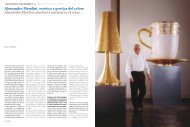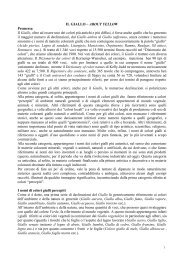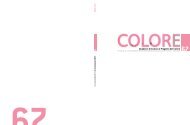Quaderni di Cultura e Progetto del Colore - Istituto Del Colore
Quaderni di Cultura e Progetto del Colore - Istituto Del Colore
Quaderni di Cultura e Progetto del Colore - Istituto Del Colore
Create successful ePaper yourself
Turn your PDF publications into a flip-book with our unique Google optimized e-Paper software.
CULTURA / CULTURE [ 1 2 3 4 ( 5 + 6 ) 7 8 9 ]<br />
za fra luminanza e brillanza. In breve, il vetro marrone<br />
trasmette una banda abbastanza ristretta <strong>di</strong><br />
lunghezza d’onda ( come l’arancio, dal quale <strong>di</strong>pende).<br />
Questa riduzione <strong>del</strong>la banda spettrale, rispetto<br />
alle con<strong>di</strong>zioni “occhio nudo”, sbilancia il sistema<br />
antagonista rosso-verde, provocando una componente<br />
cromatica <strong>del</strong>la brillanza, o brillanza cromatica<br />
che, nei centri post-recettoriali <strong>del</strong> sistema visivo,<br />
si somma con la componente usuale, dovuta<br />
alla luminanza stabilita dalla fotometria, risultando<br />
in una extra brightness..<br />
3 La libera nomenclatura<br />
Il progresso industriale legato alla produzione dei<br />
pigmenti e <strong>del</strong>le tinte con la conseguente amplificazione<br />
<strong>del</strong>la gamma <strong>di</strong> colori <strong>di</strong>sponibili, come<br />
conseguenza ha creato un aumento <strong>del</strong>la nomenclatura,<br />
che, ovviamente, ha coinvolto anche il marrone.<br />
Nel linguaggio parlato per esempio, troviamo: abbronzatura<br />
/ agata/, argilla/ autunno/ avana/ beige/<br />
bisquit/ bistro/ bois de rose/ bronzo/ bruno/ cacao/<br />
caffé e latte/camoscio/ cammello/ cannnella<br />
/ caramel/ castagna/ castano come i capelli/ cedro<br />
/ ceralacca/ cioccolata/cognac/ cuoio/ daino/ fango/<br />
noce moscata/ paglia / rame / ruggine/ tabacco/<br />
tappo / tartaruga/ terra bruciata/, testa <strong>di</strong> moro<br />
/ zenzero.<br />
Il privato citta<strong>di</strong>no ha quin<strong>di</strong> un mezzo, sia pure approssimativo,<br />
per orientare il fornitore sul tipo <strong>di</strong><br />
acquisto che egli intende fare..<br />
Nel linguaggio professionale, nell’architettura e decorazione<br />
<strong>di</strong> interni, troviamo i termini legati ai campioni<br />
<strong>del</strong> Sistema dei Color <strong>del</strong>l’Ungherese Nemcsics,<br />
denominato Coloroid. Per il marrone troviamo:<br />
oliva verde/marrone /marrone cannella/ marrone<br />
tabacco/ marrone Bruxelles/ marrone carruba/ beige<br />
marrone/ marrone Nigeria / marrone caramel/<br />
marrone Sahara/ marrone agata/ marrone mummia/<br />
marrone cipolla/ marrone caffè / marrone conchiglia<br />
/ marrone ruggine / marrone garnet/ ombra<br />
bruciata / marrone realgar/<br />
Procedendo per via empirica, o in relazione ad un<br />
particolare Sistema <strong>di</strong> Or<strong>di</strong>ne <strong>del</strong> <strong>Colore</strong>, non si risolve<br />
il problema alla ra<strong>di</strong>ce, su base scientifica. Il<br />
problema dal punto <strong>di</strong> vista degli architetti è stato<br />
trattato, per esempio, da Connor et al. (1989)<br />
4 L’alleanza fra Antropologia e Scienza <strong>del</strong>la Visione<br />
conferisce al marrone la dovuta auto-sufficienza<br />
La base scientifica alla denominazione dei colori è<br />
scaturita da alcune teorie fisiologiche, elaborate da<br />
antropologi (ci riferiamo a Berlin, Kay, Mac Daniel<br />
fee and milk / chamois / camel /cinnamon / caramel<br />
/ chestnut / chestnut hair /cedar / sealing wax /<br />
chocolate / cognac / leather / buck / doe / tortoise /<br />
scorched earth / mud / nutmeg / straw / rust / tobacco<br />
/ cork / ginger / very dark brown (testa <strong>di</strong> moro)<br />
In this way, the layman is given a tool (however<br />
aproximate it is ) to communicate with the supplier<br />
of paints and similar about his intentions, needs<br />
and preferences.<br />
In the professional language one meets, for instance,<br />
the terms related to the Color System of<br />
the Hungarian Nemcsics, named Coloroid, mainly<br />
devoted to architects. For brown, one finds:<br />
olive/ brown / brown cinnamonum /brown tobacco<br />
/ brown Brusselles / brown carob / beige brown /<br />
brown Nigeria / caramel / brown Sahara / brown<br />
agate / brown mummy / brown onion / brown coffee<br />
/ brown shell / brown rust / brown garnet / butnt<br />
shadow / burnt realgar .<br />
Nw, the problem of appropriate terminology is not<br />
solved on a scientific basis either empirically, or<br />
by making reference to a particular color order<br />
system. A <strong>di</strong>scussion on this topic, concerning the<br />
architects, is due to Connor et al. (1989).<br />
4 The self sufficing of brown, thanks to the link<br />
Anthropology - Visual Science<br />
The scientific basis of color naming originates from<br />
some Philosophical theories elaborated by the Anthropologists<br />
(Berlin, Kay, Mac Daniel et al.) who,<br />
in the sixities grouped perceived and memorized<br />
colors on the basis of a limited number of colors,<br />
the so-called basic categories. All other terms could<br />
then be derived from them.<br />
Now, higher level Physiology of the visual process<br />
has established the functional <strong>di</strong>fference between<br />
the two brain hemospheres. Color, as a visual image,<br />
is processed by the right hemisphere, based<br />
on experience. On the other hand, the left hemisphere<br />
processes mainly the verbal, logical information<br />
as well as the verbal function. All tit sown<br />
how important color naming is. However, the mental<br />
development should not be forgotten, as transferred<br />
to the anthropological evolution by Berlin<br />
and Kay. Briefly, the number of basic categorical<br />
names increases when passing from the first to<br />
the seventh stage:<br />
Evolutionary. Names of basic<br />
stage colors<br />
1st black, white<br />
2nd black, white, red<br />
ecc.) negli anni Sessanta considerarono la tendenza<br />
a raggruppare i colori, nella percezione e nella<br />
memoria, sulla base <strong>di</strong> un numero limitato <strong>di</strong> nomi<br />
, che rappresentassero le categorie <strong>di</strong> base, dalle<br />
quali si potessero poi derivare tutte le altre possibili<br />
denominazioni.<br />
La Fisiologia dei livelli superiori <strong>del</strong> processo visivo,<br />
portava a considerare la <strong>di</strong>fferenziazione fra<br />
i due emisferi cerebrali: Il colore, come immagine<br />
visiva, viene elaborata dall’emisfero destro, basata<br />
sull’esperienza. Invece l’emisfero sinistro elabora<br />
prevalentemente l’informazione verbale e<br />
logica e la funzione verbale. Tutto questo fa me<strong>di</strong>tare<br />
sull’importanza <strong>del</strong>la nomenclatura <strong>del</strong> colore<br />
(color naming). Comunque, occorre tener presente<br />
anche lo sviluppo mentale, che Berlin e Kay (nel<br />
1969) trasferirono al campo <strong>del</strong>l’evoluzione antropologica,<br />
che si era arricchita <strong>di</strong> un numero sempre<br />
crescente dei nomi dei colori durante i suoi sette<br />
sta<strong>di</strong>. Come sotto in<strong>di</strong>cato:<br />
Sta<strong>di</strong>o Nomi dei<br />
evolutivo colori <strong>di</strong> base<br />
Primo nero, bianco<br />
Secondo nero, bianco, rosso<br />
Terzo (a) nero, bianco, rosso, verde<br />
Terzo (b) nero, bianco, rosso, giallo<br />
Quarto nero, bianco, rosso, verde, giallo<br />
Quinto nero, bianco, rosso, giallo,<br />
verde, blu (sistemi antagonisti<br />
completati)<br />
Sesto nero, bianco, rosso, verde,<br />
gallo, blu, marrone<br />
Settimo nero, bianco, rosso, verde,<br />
giallo, blu, marrone, porpora,<br />
rosa,arancio.grigio<br />
La sequenza non è casuale, ma riflette l’evoluzione<br />
antropologica<br />
La ricerca è stata animata da <strong>di</strong>battiti. Chi preferiva<br />
il nome <strong>di</strong> violetto al porpora, chi chiedeva<br />
spiegazioni <strong>del</strong> fatto che il marrone , nel linguaggio,<br />
fosse più antico <strong>del</strong>l’arancio, dal quale, secondo<br />
le precedenti concezioni correnti, <strong>di</strong>pendeva.<br />
Ma c’era anche chi accusava l’arancio <strong>di</strong> non essere<br />
un autonomo colore <strong>di</strong> base, ma il risultato <strong>del</strong>la<br />
mescolanza <strong>di</strong> rosso e giallo Infine, il grigio. Chi<br />
considera presente nell’organizzazione antagonista,<br />
la coppia bianco-nero, considera il grigio come<br />
il risultato <strong>di</strong> una mescolanza interme<strong>di</strong>a, durante<br />
il corso <strong>del</strong> raggiungimento <strong>del</strong> punto <strong>di</strong> equilibrio.<br />
Ma,se, invece, gli <strong>di</strong>amo la <strong>di</strong>gnità <strong>di</strong> colore <strong>di</strong> base<br />
3rd (a) black, white, red, green<br />
3rd (b) black, white, red, yellow<br />
4th black, white, red, green, yellow<br />
5th black, white, red, yellow, green,<br />
blue (opponent systerms are<br />
now completed)<br />
6th black, white, red, green, yellow,<br />
blue, brown<br />
7th black, white, red, green, yellow,<br />
blue, brown, purple, pink,<br />
orange, grey<br />
This sequence is not random, but it reflects the anthropological<br />
evolution.<br />
The list of the eleven basic names (see 7th stage)<br />
has been and is yet debated. Somebody prefers<br />
the name violet in the place of purple; others raise<br />
the question why brown precedes orange in the<br />
progress of evolution, once accepted that brown<br />
is a particularly <strong>di</strong>mmed orange. Somebody maintains<br />
that orange cannot be a basic color, being a<br />
mixture of red and yellow. At last, also grey is controversial.<br />
Considering it as a basic color requires<br />
exclu<strong>di</strong>ng black and white from the list, leaving<br />
only red-green and blue-yellow. That is, as a basic<br />
category, grey is a self stan<strong>di</strong>ng volor, not one of<br />
the stages of the white and black mixture. Moreover,<br />
if basicness is assigned to it, why is it located<br />
after purple (or violet) and brown in the evolutionary<br />
hierarchy?<br />
Again in 1969, Berlin and Kay showed that the eleven<br />
basic categories exist with the same frequency of<br />
A proposito <strong>del</strong> marrone ... / About the ubiquitous...<br />
14 COLORE COLORE 15












